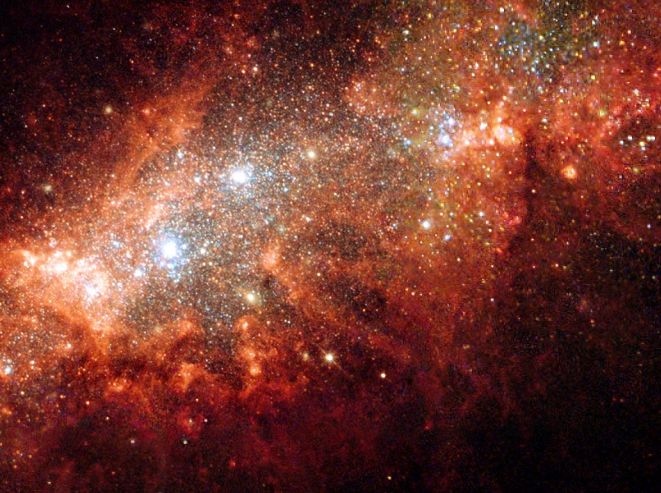搜索到
3
篇与
的结果
-
 2017年06月27日:共照耀星云后方的M81星系群-(The M81 Galaxy Group through the Integrated Flux Nebula) 2017年06月27日:共照耀星云后方的M81星系群-(The M81 Galaxy Group through the Integrated Flux Nebula)--原图下载{mtitle title="共照耀星云后方的M81星系群"/}Image Credit & Copyright : D. Lopez & A. Rosenberg, IAC说明: 这幅M81星系群的深空影像,同时突显了遥远的星系和邻近的星云。在这幅由80张照片併接而成的影像里,最醒目的是位在右下角最为庞大和宏伟的螺旋星系M81。M81和它上方拥有不寻常丝缕状辉光云气丝的M82,透过重力进行交互作用。此外在影像各处,还可见到M81星系群的其他星系与及隶属于银河系的前景恒星。影像中的这个星系大观园,位在共照耀星云(IFN)的辉光之后方,而这片广袤的弥漫气体和尘埃云则位在我们银河系之内。这些细部结构经过数位强化的红色和黄色IFN,是由西班牙.加那利群岛.泰德天文台最近安装的广视野相机所拍摄。{lamp/}原文:{mtitle title="The M81 Galaxy Group through the Integrated Flux Nebula"/}Image Credit & Copyright : D. Lopez & A. Rosenberg, IACExplanation: Distant galaxies and nearby nebulas highlight this deep image of theM81Group of galaxies. First and foremost in this 80-exposure mosaic is thegrand design spiral galaxyM81, the largest galaxy in the image, visible on the lower right.M81 isgravitationally interacting withM82 just above it,a large galaxy with an unusual halo of filamentary red-glowing gas. Around the image many other galaxies from theM81 Group of galaxies can be seen, as well as many foreground Milky Way stars. This whole galaxy menagerie is seen through the glow of anIntegratedFlux Nebula (IFN), a vast and complex screen of diffuse gas and dust also in ourMilky Way Galaxy.Details of the red and yellow IFN, digitally enhanced, were imaged by a new wide-field camera recently installed at the Teide Observatory in the Canary Islands of Spain.
2017年06月27日:共照耀星云后方的M81星系群-(The M81 Galaxy Group through the Integrated Flux Nebula) 2017年06月27日:共照耀星云后方的M81星系群-(The M81 Galaxy Group through the Integrated Flux Nebula)--原图下载{mtitle title="共照耀星云后方的M81星系群"/}Image Credit & Copyright : D. Lopez & A. Rosenberg, IAC说明: 这幅M81星系群的深空影像,同时突显了遥远的星系和邻近的星云。在这幅由80张照片併接而成的影像里,最醒目的是位在右下角最为庞大和宏伟的螺旋星系M81。M81和它上方拥有不寻常丝缕状辉光云气丝的M82,透过重力进行交互作用。此外在影像各处,还可见到M81星系群的其他星系与及隶属于银河系的前景恒星。影像中的这个星系大观园,位在共照耀星云(IFN)的辉光之后方,而这片广袤的弥漫气体和尘埃云则位在我们银河系之内。这些细部结构经过数位强化的红色和黄色IFN,是由西班牙.加那利群岛.泰德天文台最近安装的广视野相机所拍摄。{lamp/}原文:{mtitle title="The M81 Galaxy Group through the Integrated Flux Nebula"/}Image Credit & Copyright : D. Lopez & A. Rosenberg, IACExplanation: Distant galaxies and nearby nebulas highlight this deep image of theM81Group of galaxies. First and foremost in this 80-exposure mosaic is thegrand design spiral galaxyM81, the largest galaxy in the image, visible on the lower right.M81 isgravitationally interacting withM82 just above it,a large galaxy with an unusual halo of filamentary red-glowing gas. Around the image many other galaxies from theM81 Group of galaxies can be seen, as well as many foreground Milky Way stars. This whole galaxy menagerie is seen through the glow of anIntegratedFlux Nebula (IFN), a vast and complex screen of diffuse gas and dust also in ourMilky Way Galaxy.Details of the red and yellow IFN, digitally enhanced, were imaged by a new wide-field camera recently installed at the Teide Observatory in the Canary Islands of Spain. -
 2008年12月29日:矮星系NGC 1569内的星爆现象-(NGC 1569: Starburst in a Dwarf Irregular Galaxy) 2008年12月29日:矮星系NGC 1569内的星爆现象-(NGC 1569: Starburst in a Dwarf Irregular Galaxy)--原图下载{mtitle title="矮星系NGC 1569内的星爆现象"/}Credit: NASA,ESA,Hubble Heritage(STScI/AURA); Acknowledgement: A. Aloisi (STScI/ESA) et al.说明: 宏伟的螺旋星系通常是天之娇子,得意扬扬地展示它们对称漩涡臂上的年轻明亮星团。 不过,小型的不规则星系也会有恒星诞生活动呢。 譬如,上图中的矮星系NGC 1569就正在历经一次大量的恒星形成活动,而且启始的时间可以倒推到二千五百万年前。星爆活动所产生的混乱环境,主要是由许多的超新星爆炸所造成的。这些宇宙级爆炸不但会喷攦物质,也会触发新一波的恒星诞生活动。位在我们螺旋状银河系的两个大型星团,恰好出现在这张哈伯太空望远镜影像的中左方,它们可以视为是球状星团的年轻範例。这张影像涵盖了NGC 1569内部8000光年的区域。距离我们只有一千一百万光年的NGC 1569,是个离我们相当近的星爆星系,因此成为天文学家探索快速演化星系内恒星族群的绝佳目标。 NGC 1569位在具有长长脖子的鹿豹座(Camelopardalis)内。{lamp/}原文:{mtitle title="NGC 1569: Starburst in a Dwarf Irregular Galaxy"/}Credit: NASA,ESA,Hubble Heritage(STScI/AURA); Acknowledgement: A. Aloisi (STScI/ESA) et al.Explanation: Grand spiral galaxiesoften seem to get all the glory, flauntingtheir young, bright, blue star clusters in beautiful,symmetric spiral arms.But small, irregular galaxiesform stars too.In fact, as pictured here, dwarf galaxy NGC 1569 is apparently undergoing a burst of star forming activity, thoughtto have begun over 25 million years ago.The resulting turbulent environment isfed by supernova explosions as the cosmic detonations spew out material and trigger further star formation.Two massive star clusters - youthful counterparts toglobularstar clustersin our own spiral Milky Way galaxy - are seen left of center in the gorgeousHubble Space Telescope image.The above picture spans about 8,000 light-years across NGC 1569.A mere 11 million light-years distant,this relatively close starburst galaxy offers astronomers anexcellent opportunityto studystellar populations in rapidly evolving galaxies.NGC 1569 lies in thelong-neckedconstellationCamelopardalis.
2008年12月29日:矮星系NGC 1569内的星爆现象-(NGC 1569: Starburst in a Dwarf Irregular Galaxy) 2008年12月29日:矮星系NGC 1569内的星爆现象-(NGC 1569: Starburst in a Dwarf Irregular Galaxy)--原图下载{mtitle title="矮星系NGC 1569内的星爆现象"/}Credit: NASA,ESA,Hubble Heritage(STScI/AURA); Acknowledgement: A. Aloisi (STScI/ESA) et al.说明: 宏伟的螺旋星系通常是天之娇子,得意扬扬地展示它们对称漩涡臂上的年轻明亮星团。 不过,小型的不规则星系也会有恒星诞生活动呢。 譬如,上图中的矮星系NGC 1569就正在历经一次大量的恒星形成活动,而且启始的时间可以倒推到二千五百万年前。星爆活动所产生的混乱环境,主要是由许多的超新星爆炸所造成的。这些宇宙级爆炸不但会喷攦物质,也会触发新一波的恒星诞生活动。位在我们螺旋状银河系的两个大型星团,恰好出现在这张哈伯太空望远镜影像的中左方,它们可以视为是球状星团的年轻範例。这张影像涵盖了NGC 1569内部8000光年的区域。距离我们只有一千一百万光年的NGC 1569,是个离我们相当近的星爆星系,因此成为天文学家探索快速演化星系内恒星族群的绝佳目标。 NGC 1569位在具有长长脖子的鹿豹座(Camelopardalis)内。{lamp/}原文:{mtitle title="NGC 1569: Starburst in a Dwarf Irregular Galaxy"/}Credit: NASA,ESA,Hubble Heritage(STScI/AURA); Acknowledgement: A. Aloisi (STScI/ESA) et al.Explanation: Grand spiral galaxiesoften seem to get all the glory, flauntingtheir young, bright, blue star clusters in beautiful,symmetric spiral arms.But small, irregular galaxiesform stars too.In fact, as pictured here, dwarf galaxy NGC 1569 is apparently undergoing a burst of star forming activity, thoughtto have begun over 25 million years ago.The resulting turbulent environment isfed by supernova explosions as the cosmic detonations spew out material and trigger further star formation.Two massive star clusters - youthful counterparts toglobularstar clustersin our own spiral Milky Way galaxy - are seen left of center in the gorgeousHubble Space Telescope image.The above picture spans about 8,000 light-years across NGC 1569.A mere 11 million light-years distant,this relatively close starburst galaxy offers astronomers anexcellent opportunityto studystellar populations in rapidly evolving galaxies.NGC 1569 lies in thelong-neckedconstellationCamelopardalis. -
 2004年02月05日:小星系NGC 1569内的星爆现象-(NGC 1569: Starburst in a Small Galaxy) 2004年02月05日:小星系NGC 1569内的星爆现象-(NGC 1569: Starburst in a Small Galaxy)--原图下载{mtitle title="小星系NGC 1569内的星爆现象"/}Credit: ESA,NASA,P. Anders(G�ttingen Univ.)et al.说明: 宏伟的螺旋星系通常是天之娇子,得意扬扬地展示它们对称漩涡臂上的年轻明亮星团。不过,小型的不规则星系也会有恒星诞生活动呢。譬如,上图中的矮星系NGC 1569就正在历经一次大量的恒星形成活动,而且启始的时间可以倒推到二千五百万年前。星爆活动所产生的混乱环境,主要是由许多的超新星爆炸所造成的。这些宇宙级爆炸不但会喷攦物质,也会触发新一波的恒星诞生活动。位在我们螺旋状银河系的两个大型星团,恰好出现在这张哈伯太空望远镜影像的中左方,它们可以视为是球状星团的年轻範例。这张影像涵盖了NGC 1569内部1500光年的区域。距离我们只有七百万光年的NGC 1569,是个离我们相当近的星爆星系,因此成为天文学家探索快速演化星系内恒星族群的绝佳目标。NGC 1569位在具有长长脖子的鹿豹座 (Camelopardalis)内。{lamp/}原文:{mtitle title="NGC 1569: Starburst in a Small Galaxy"/}Credit: ESA,NASA,P. Anders(G�ttingen Univ.)et al.Explanation: Grand spiral galaxiesoften seem to get all the glory, flauntingtheir young, bright, blue star clusters in beautiful,symmetric spiral arms.But small, irregular galaxiesform stars too.In fact, as pictured here, dwarf galaxyNGC 1569 is apparently undergoing a burst of star forming activity, thoughtto have begun over 25 million years ago.The resulting turbulent environment isfed by supernovaexplosions as the cosmic detonations spew out material and triggerfurther star formation.Two massive star clusters - youthful counterparts toglobularstar clustersin our own spiral Milky Way galaxy - are seen left of center in the gorgeousHubble Space Telescope image.The picture spans about 1,500 light-years across NGC 1569.A mere 7 million light-years distant,this relatively close starburst galaxy offers astronomers anexcellent opportunityto studystellar populations in rapidly evolving galaxies.NGC 1569 lies in thelong-neckedconstellationCamelopardalis.
2004年02月05日:小星系NGC 1569内的星爆现象-(NGC 1569: Starburst in a Small Galaxy) 2004年02月05日:小星系NGC 1569内的星爆现象-(NGC 1569: Starburst in a Small Galaxy)--原图下载{mtitle title="小星系NGC 1569内的星爆现象"/}Credit: ESA,NASA,P. Anders(G�ttingen Univ.)et al.说明: 宏伟的螺旋星系通常是天之娇子,得意扬扬地展示它们对称漩涡臂上的年轻明亮星团。不过,小型的不规则星系也会有恒星诞生活动呢。譬如,上图中的矮星系NGC 1569就正在历经一次大量的恒星形成活动,而且启始的时间可以倒推到二千五百万年前。星爆活动所产生的混乱环境,主要是由许多的超新星爆炸所造成的。这些宇宙级爆炸不但会喷攦物质,也会触发新一波的恒星诞生活动。位在我们螺旋状银河系的两个大型星团,恰好出现在这张哈伯太空望远镜影像的中左方,它们可以视为是球状星团的年轻範例。这张影像涵盖了NGC 1569内部1500光年的区域。距离我们只有七百万光年的NGC 1569,是个离我们相当近的星爆星系,因此成为天文学家探索快速演化星系内恒星族群的绝佳目标。NGC 1569位在具有长长脖子的鹿豹座 (Camelopardalis)内。{lamp/}原文:{mtitle title="NGC 1569: Starburst in a Small Galaxy"/}Credit: ESA,NASA,P. Anders(G�ttingen Univ.)et al.Explanation: Grand spiral galaxiesoften seem to get all the glory, flauntingtheir young, bright, blue star clusters in beautiful,symmetric spiral arms.But small, irregular galaxiesform stars too.In fact, as pictured here, dwarf galaxyNGC 1569 is apparently undergoing a burst of star forming activity, thoughtto have begun over 25 million years ago.The resulting turbulent environment isfed by supernovaexplosions as the cosmic detonations spew out material and triggerfurther star formation.Two massive star clusters - youthful counterparts toglobularstar clustersin our own spiral Milky Way galaxy - are seen left of center in the gorgeousHubble Space Telescope image.The picture spans about 1,500 light-years across NGC 1569.A mere 7 million light-years distant,this relatively close starburst galaxy offers astronomers anexcellent opportunityto studystellar populations in rapidly evolving galaxies.NGC 1569 lies in thelong-neckedconstellationCamelopardalis.




